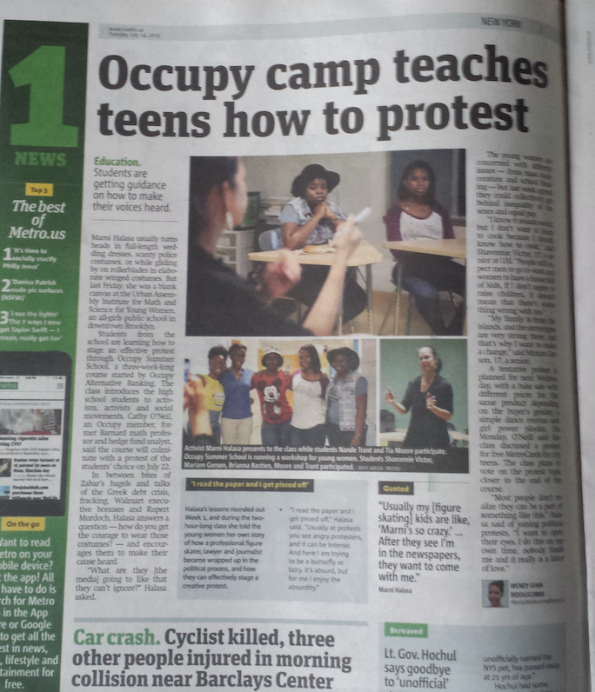Home
> Uncategorized > Occupy Summer School in the Metro!
Occupy Summer School in the Metro!
July 15, 2015
Yesterday, as I was accompanying Adam Reich to the Occupy Summer School on the downtown 2 train, he pointed over my shoulder at someone reading a Metro, because the girls were on the front page:
We also were on the second page:
After I got to the UAI, the high school where we run Occupy Summer School, I found the online version of the Metro story as well, which is also exciting.
Since Occupy Summer School (OSS) is half over, I think it’s a good time to update you on what’s been happening.
- Last Monday we introduced ourselves, met the students, talked a little bit about Occupy, agreeable disagreement, and had a discussion about what they wanted to focus on using “stack.” Among the issues they came up with: inequality, Black Lives Matter, taxing the rich, how teenagers are unfairly targeted, and gender issues.
- Tuesday Ale and Mo, a high school activist, came and talked to the girls about activism. We discussed how organizing actually works, what were the props for events, like stickers, flyers, signs and banners, how to get the word out among networks via text or twitter or other social media, and so on. We ended the day by quickly planning a protest against overly lengthy standardized tests.
- Wednesday Tamir’s friends from Local 79 came and talked about unions and union organizing. The girls didn’t know much about unions, and were interested to learn how power can be created through numbers.
- Thursday Gerald provoked a fantastic discussion on #BlackLivesMatter and related topics. This was the first time where the girls really took over the discussion and the grownups in the room were merely listening and every now and then joining the discussion.
- Friday Marni dazzled the girls with her approach to creative protests. She brought her own entourage, which ended up being how we got into the Metro. The day ended by planning a bake sale where women would be charged 78 cents and men one dollar for the same brownies, to illustrate the difference in pay.
- This Monday I spoke to the girls about “why high school is free but college is expensive,” and then about debt more generally. We ended the day by planning a protest around a $100 ticket one of the girls had gotten for “doubling up” in the subway with her cousin, who didn’t have a student Metro card. The demand was to be unlimited metro rides for high school students on all days, not just school days.
- Yesterday Adam came and talked to them about sociology, what is power (power is the opposite of dependence), and his work helping orgainze workers at Walmart. By the end of it he had two volunteers who wanted to join the cause.
I can’t wait for the rest of OSS! I’ll write another update at the end of next week when it’s over.
Categories: Uncategorized





So proud of all you do!
LikeLike
I wonder about the ROI of various different types of political engagement, including variations of protests. Are there any quantitative measures one could use? Qualitatively, what do political scientists and historians think?
For example, the US has a protest story as part of its founding mythology: the Boston Tea Party. Wikipedia, at least, presents it as a critical event in the lead-up to revolution, but I’d flag that the response by the British government to the protest was a necessary component in the impact chain. Given the intervening events, I think it would be hard to claim that this protest directly related to the repeal of the Tea Act (again leaning on Wikipedia as my source).
Similarly, the Vietnam war protests led to many indirect changes (or maybe those changes were caused by the things that contributed to the protests?), but didn’t seem to have much effect on US policy in Vietnam itself.
FWIW, the non-US versions I know personally have not really be grass-roots protests, but are showpieces used by powerful incumbent interest groups, so I don’t think they really count.
What about other famous protest movements: the US civil rights struggle, Gandhi’s independence movement, Mandela’s anti-apartheid struggle, etc?
My personal hypothesis is that the real point of leverage is not the protests themselves, but the government’s (or other power holder’s) reaction to the protests. As a strategic game, the protesters want to find the right level of irritating so that:
(a) they won’t look like bad actors themselves
(b) the government will hit back unreasonably hard
On the opposite team, the incumbent power wants to calibrate a response so that:
(1) they are not, de facto, ceding a key power
(2) the protesters are not encouraged
(3) the response doesn’t appear worse than the protests
I’m looking forward to being better informed and corrected…
LikeLike
Given that most protests are designed to provoke a response, I’m not sure the distinction is meaningful.
LikeLike